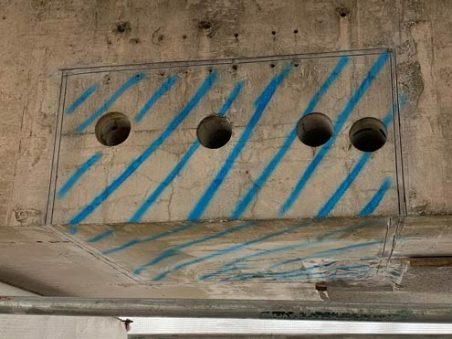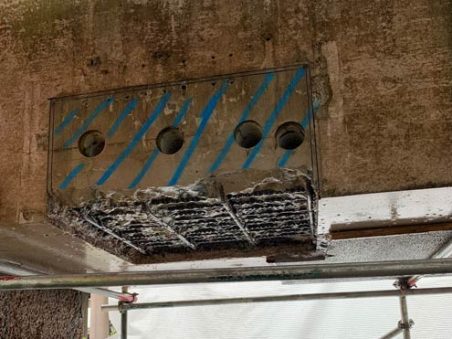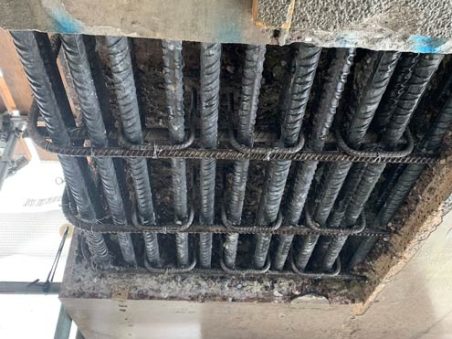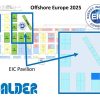the challenge
Removing a section of concrete from the underside of a flyover – a great way to demonstrate the very latest in ultra-high pressure, low emissions waterjetting technology and the advantages of hydrodemolition.
A common issue with raised sections of motorway is the deterioration of the concrete over two decades or so of exposure to the elements. The unstable concrete has to be removed and replaced with fresh concrete. However, the concrete must be removed without damage to the original rebar. Traditional percussive demolition techniques can damage the rebar and also cause micro-fractures in the surrounding good concrete. With a large project soon to commence, a suitable, efficient method of concrete removal was required.
The purpose of this on-site demonstration was two-fold: show that hydro demolition is the best method for the removal of concrete, achieving the required standard at the required removal rate and that the latest Calder EU STAGE V emissions-compliant MultiJet machine is the right tool for the project.
The demonstration was carried out in conjunction with West Midlands based Trident Hydro Demolition. Trident have significant experience working with high pressure water for hydro demolition, surface preparation, and water jet cutting.
why hydrodemolition
Hydro demolition has both operator health & safety and methodological advantages over traditional methods of concrete removal. For this project, it is only the selected areas of concrete to be removed. The original rebar will be re-used – providing it is not damaged or corroded. Hydro demolition uses a high pressure jet of water at a pressure, normally above 1100 bar, enabling concrete removal faster than using a jackhammer but without affecting the metal rebar. Where the mechanical impact of a jackhammer can cause small cracking in the surrounding healthy concrete, hydro demolition affects only the concrete that it comes into contact with.
The vibrations jackhammer users will be all too familiar with do not exist with high pressure water jetting; The recent Hand Arm Vibration (HAV) legislation has led to a huge increase in the use of high pressure water jetting for Hydrodem applications. Furthermore, with hydro demolition, operators benefit from reduced noise and dust. The finish achieved with hydro demolition gives a surface which is ideal for bonding between old and new concrete. In addition to the benefits already mentioned, hydro demolition is, quite simply, much quicker than traditional techniques.
In the sections of concrete to be removed, there are three layers of rebar, and our customer selected removal by hand lance. On many projects, semi-automated robots can be used to remove the operator from the jetting area.
Check out this news item about the huge Kariba Dam Rehabilitation Project.



Calder EU STAGE V emissions compliant, mobile waterjetting unit
The recent launch of our latest generation of mobile MultiJet waterjetting units, sees the introduction of the very latest in lowest polluting engine technology, meeting the latest ‘EU STAGE V’ emissions engine requirements. The EU STAGE V regulations for non-road machinery impose stricter limits on harmful emissions than its predecessor, the STAGE IV, and the limits are a fraction of what was allowed in the STAGE I version some twenty years ago. This MultiJet has the lowest carbon footprint we have ever achieved.
This mobile, 3,000 bar MultiJet is packed with features that have been added and developed over more than 20 years through a close working relationship with our customers. Feedback from the customers and the hands-on operators of this equipment has helped to develop this machine into the reliable, trusted tool that our customers can rely on, whether it is used in the construction & civil engineering, petrochemical, refining or nuclear industries.
At the heart of the unit is the pump. Our MultiJet machines feature the ultra-reliable, Hammelmann reciprocating plunger pump. The pump features a small-footprint, vertical design, and packing-free technology which is a huge benefit to our customers allowing a much longer service interval, reducing maintenance costs and maximising uptime.
Standard features
- Continuous water filter monitoring with on-screen alarm and shutdown facility.
- Exhaust spark arrester fitted.
- Boost pump eliminates cavitation and guarantees inlet water feed pressure.
- Electronic throttle control ensures that the engine speed increases only when pressure is demanded. Saves fuel and water without needing hoses and cables for actuation.
- Lightweight, GRP noise-reducing cover which reduces noise emissions, protects components from damage and offers excellent weather protection.
- Fuel tank integrated into baseframe giving a low centre of gravity.
- 175 litre capacity, stainless steel water inlet tank designed to allow adequate time to de-aerate and reduce feed waterinlet velocity .
- All mounted onto high quality, road-going running gear, with adjustable height tow hitch and LED lighting .
The latest in HMI touchscreen control and monitoring is fitted as standard with both touchscreen and pushbuttons to give the operator choice and flexibility. An easy-to-use menu guides the operator through screen displays for; unit performance, pump monitoring, engine monitoring, and fault finding.
Comprehensive measuring, monitoring, alarm and shutdown functions ensure complete control over all processes, parameters and critical equipment. Operating parameters can be managed and restricted through a tiered approach to control panel settings access.





